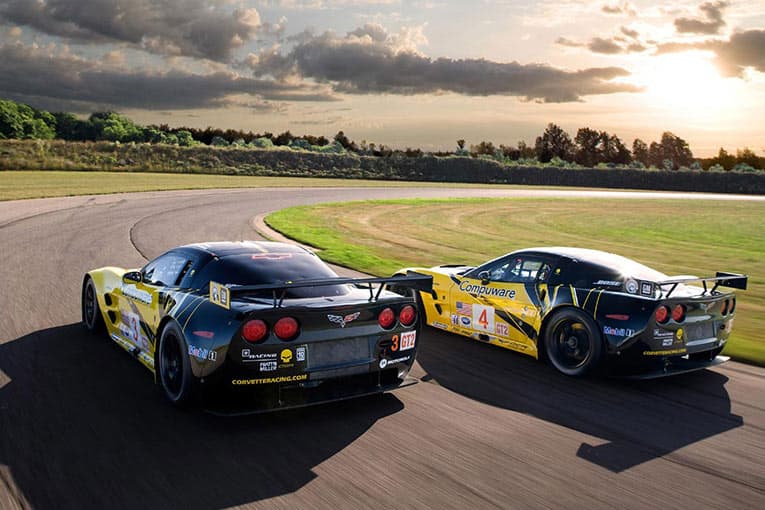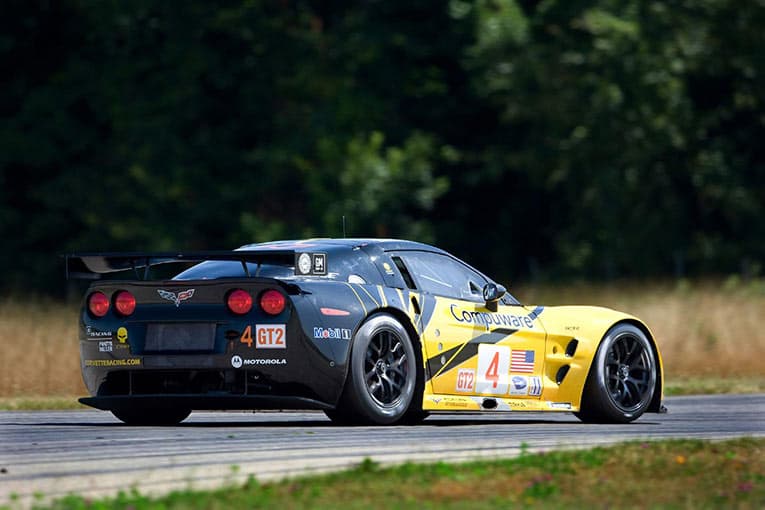In the 2010 American Le Mans Series, Corvette Racing will compete in the series’ production-based GT category (formerly GT2) and in the GT2 class at the 24 Hours of Le Mans with a second-generation C6.R that is homologated on the Corvette ZR1. The GT rules require the use of many production-based components, making the ZR1 and C6.R the closest street and racing Corvettes since the 1960s.
Introduced for the 2009 model year, the ZR1 is the fastest, most powerful car ever produced by Chevrolet. To deliver 638 hp, the LS9 V-8 engines are hand-built using many of the processes developed by the race team. To deliver a 205-mph top speed, the ZR1 aerodynamics package also utilizes race technology – including wide carbon fiber front fenders with dual vents, a full-width rear spoiler, and a front splitter.

The updated C6.R utilizes the ZR1 body design, aerodynamic package, aluminum frame and chassis structure, steering system, windshield, and other components.
Aluminum frame: The new Corvette C6.R is built on the same aluminum frame rails that underpin production Corvette Z06 and ZR1 models. Other production chassis structures in the race car include the windshield frame, the hoop around the rear of the passenger compartment, the door hinge pillars, the drivetrain tunnel, the firewall, and the floor pan.
Steering system: The new Corvette C6.R utilizes the production steering column out of the ZR1, with a fully adjustable steering wheel, and production rack-and-pinion steering rack.

Body profile: The Corvette C6.R race car is now virtually identical to the Corvette ZR1 street car in appearance, as GT rules require production-type fenders with simple flares to accommodate wider tires.
Aerodynamics: The new C6.R utilizes the full-width, production rear spoiler from the ZR1, and a production-based ZR1 front splitter that extends 25mm, in contrast to the 80mm splitter allowed under the GT1 rules. Although the aerodynamics package does not produce the same levels of downforce as the GT1 car, the C6.R is more predictable over a wide range of speeds.
Where the C6.R and ZR1 differ significantly are in situations where GT rules actually prohibited the use of the more sophisticated ZR1 components. For example, the ZR1 is equipped with carbon-composite brake rotors, while GT regulations require ferrous (steel) brake discs. And, where the ZR1 utilizes a 6.2L, supercharged V-8, the C6.R will use a naturally aspirated small-block, production-based 5.5L V-8. The Corvette C6.R race cars’ 5.5-liter Chevrolet small-block V8s are developed, built and maintained by GM. The Corvette C6.Rs’ LS5.5R is a naturally aspirated race engine, based on the Corvette Z06’s 7.0-liter LS7 engine (which in turn was developed with the 7.0L race engine used in the C6.R GT1 cars), built on production cast-aluminum cylinder blocks.

Pending GT2 class regulations specify a maximum displacement of 5.5 liters, the reduction in displacement to meet this requirement was achieved by shortening the crankshaft stroke and reducing the cylinder bore diameter. In accordance with the regulations, the race engines have two 28.8mm diameter intake air restrictors. The LS5.5R engines are equipped with dry-sump oiling systems, CNC-ported aluminum cylinder heads with titanium intake and exhaust valves, and sequential electronic port fuel injection. The race engines use E85R ethanol racing fuel in the ALMS and E10 fuel in Le Mans.










